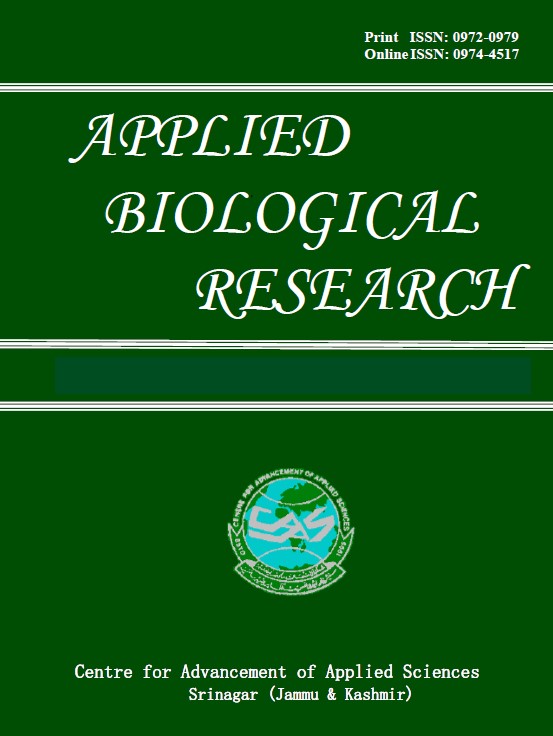Trigonella foenum-graecum-BASED GREEN SYNTHESIS OF NANO- PARTICLES: PRODUCTION, CHARACTERIZATION AND APPLICATIONS
DOI:
https://doi.org/10.48165/abr.2025.27.01.29Keywords:
Green nanotechnology, phytochemical-mediated synthesis, silver nanoparticles, sustainable nanomaterials, Trigonella foenum- graecumAbstract
Nanoparticles (1–100 nm) are increasingly explored for environmental and biomedical applications. In this study, silver nanoparticles (AgNPs) were synthesized using Trigonella foenum-graecum (fenugreek) seed extract as a natural reducing and capping agent. Phytochemicals such as flavonoids, saponins, and polyphenols facilitated efficient formation and long-term stabilization of AgNPs. The synthesis, confirmed by surface plasmon resonance with an absorption peak at 420 nm, was further characterized by FTIR, revealing functional groups (C=C, O-H/N-H) responsible for reduction and capping. The AgNPs demonstrated strong antimicrobial activity against E. coli (19 mm) and S. aureus (17 mm), with MIC values of 25–50 μg/mL. Antioxidant potential was confirmed by DPPH assay (IC₅₀ = 46 μg/mL), indicating potent radical scavenging activity. The nanoparticles exhibited high yield (>85%), 30-day stability, and resistance to agglomeration. Bioactivity profiling across varying concentrations (100, 75, 50, and 25%) highlighted dose-dependent responses. The results suggest that fenugreek-mediated AgNPs act through membrane disruption, ROS generation, and interference with microbial DNA/protein synthesis. This green synthesis approach underscores the multifunctionality and sustainability of fenugreek-based AgNPs as promising next-generation antimicrobial agents.
Downloads
References
Ahmed, S., Ahmad, M., Swami, B.L., & Ikram, S. (2016). A review on plants extract mediated synthesis of silver nanoparticles for antimicrobial applications: A green expertise. Journal of Advanced Research, 7, 17–28.
Alshafei, A.A., Ibrahim, E.H., Refat, M.A., & Al-Salhi, M.S. (2022). Antibacterial activity of biosynthesized silver nanoparticles using fenugreek seed extract. Saudi Journal of Biological Sciences, 29, 3341–3348.
Aswathi, R., Viji, D., Charmine, P.S.P., Husain, R.S.R.A., Ameen, S.H.N., Ahmed, S.S., et al. (2020). Influence of KCNJ11 gene polymorphism in T2DM of south Indian population. Frontiers in Bioscience-Elite, 12, 199–222.
Awad, M.A., Eid, A.M., Elsherbiny, E.A., & Mohamed, N.S. (2016). Antibacterial activity of silver nanoparticles synthesized using extract of Aloe vera leaves. Journal of Radiation Research and Applied Sciences, 9, 262–270.
Bhargave, A., Ahmad, I., Yadav, A., & Gupta, R. (2023). Correlating the role of KCNJ11 polymorphism (rs5219) and T2DM: A case control study. International Journal of Diabetes in Developing Countries, 44, 175–181.
Čejková, P., Novota, P., Černá, M., Kološtová, K., Nováková, D., & Kučera, E. (2007). KCNJ11 E23K polymorphism and diabetes mellitus with adult onset in Czech patients. Folia Biologica (Praha), 53, 173–175.
Chistiakov, D.A., Potapov, V.A., Khodirev, D.C., Shamkhalova, M.S., & Shestakova, M.V. (2009). Genetic variations in the pancreatic ATP-sensitive potassium channel, B-cell dysfunction, and susceptibility to type 2 diabetes. Acta Diabetologica, 46, 43–49.
Duda-Chodak, A., & Tarko, T. (2007). Antioxidant properties of different fruit seeds and peels. Acta Scientiarum Polonorum Technologia Alimentaria, 6, 29–36.
Heim, K.E., Tagliaferro, A.R., & Bobilya, D.J. (2002). Flavonoid antioxidants: Chemistry, metabolism and structure–activity relationships. Journal of Nutritional Biochemistry, 13, 572–584.
Iravani, S. (2011). Green synthesis of metal nanoparticles using plants. Green Chemistry, 13, 2638–2650.
Kaviarasan, S., Naik, G.H., Gangabhagirathi, R., Anuradha, C.V., & Priyadarsini, K.I. (2007). In vitro studies on antiradical and antioxidant activities of fenugreek (Trigonella foenum-graecum) seeds. Food Chemistry, 103, 31–37.
Kora, A.J. (2018). Leaves of Moringa oleifera as bioreductant in the synthesis of silver nanoparticles and its antibacterial activity. Journal of Saudi Chemical Society, 22, 925–931.
Kumar, R., Paul, S., & Jain, S.K. (2019). TLC bioautography-guided screening of antibacterial compounds from plant extracts. Pharmacognosy Research, 11, 26–30.
Morones, J.R., Elechiguerra, J.L., Camacho, A., Holt, K., Kouri, J.B., Ramirez, J.T., et al. (2005). The bactericidal effect of silver nanoparticles. Nanotechnology, 16, 2346–2353.
Prasad, T., & Elumalai, E.K. (2011). Biofabrication of Ag nanoparticles using Moringa oleifera leaf extract and their antimicrobial activity. Asian Pacific Journal of Tropical Biomedicine, 1, 439–442.
Salam, S.G.A., Rashed, M.M., Ibrahim, N.A., Rahim, E.A.A., Aly, T.A.A., Al-Farga, A., et al. (2023). Phytochemical screening and in vitro biological properties of unprocessed and household processed fenugreek (Trigonella foenum-graecum Linn.) seeds and leaves. Scientific Reports, 13(1), 7032. https://doi.org/10.1038/s41598-023-31888-y
Sharma, V.K., Yngard, R.A., & Lin, Y. (2009). Silver nanoparticles: Green synthesis and their antimicrobial activities. Advances in Colloid and Interface Science, 145, 83–96.
Singh, A., Jain, D., Upadhyay, M., Khandelwal, N., & Verma, H.N. (2010). Green synthesis of silver nanoparticles using Argemone mexicana leaf extract and evaluation of their antimicrobial activities. Digest Journal of Nanomaterials and Biostructures, 5, 483–489.
Singh, R., & Bhargava, A. (2012). Antioxidant activity of phenolic compounds in fenugreek seeds. Journal of Pharmaceutical Research, 5, 5003–5005.
Song, J.Y., & Kim, B.S. (2009). Rapid biological synthesis of silver nanoparticles using Plantago asiatica extract. Bioprocess and Biosystems Engineering, 32, 79–84.

